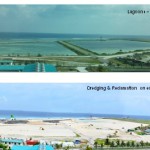Preliminary results from the 2014 census show the Maldivian population has grown by 14.1 percent since 2006, with foreigners – not included in the last census – making up 14.6 percent of the total.
The first census taken in eight years shows the Maldivian population to have grown by an average of 1.56 per year, now numbering 341,256, while the expatriate population added another 58,683 to the total number.
Information gathered by the National Bureau of Statistics between September 20 and 30 showed that the capital Malé now contains 38.98 percent of the population, with the capital’s Maldivian population growing by close to 3 percent since 2006.
The expatriate population in the capital is 13.2 percent of the total, while foreigners make up 7.1 percent of the population in the country’s other administrative islands.
The average male to female ratio in the capital is 103 males to every 100 females, with 99 males for every 100 females in Malé and 93 males for every 100 females in the administrative islands.
After the capital city, the most populous regions in the country were Haa Dhaalu Atoll (18,254), Seenu Atoll (19,712), and Raa Atoll (14,865). Alif Alif (8.2 percent) and Seenu (7.8 percent) atolls have the highest percentage of foreigners, after Malé Atoll (10.3 percent).
The atoll with the most males to females was Kaafu, with a ratio of 119:100, while Haa Alif and Fuvahmulah just 83 males for every 100 females.
Islands experiencing the largest changes in population since 2006 were recorded as being Haa Dhaalu Nolhivaranfaru, which grew by a yearly average of 15.98 percent, while the island of Buruni in Thaa Atoll dropped by an average of 15.25 percent each year.
*The original version of this article stated the growth rate as 12.1 percent, but the 42,288 additional Maldivians counted represents 14.1 percent of the 2006 count.






At this rate, in 50 years, we will have to build rafts to live on the high seas!
The current rate of population growth is not sustainable and the country cannot afford to feed all these people in the future, never mind other necessities such as health and education.
Population growth is 12%
Is there a plan for 12% growth in jobs, housing, social services.. probably not.
Also 350,000 population is too less. Incentives need to be given to make the population 1 Million in 20 years.
1 million in 20 years? I think we better hurry up and make that 10 years. We can do it, since we're very good at breaking these kind of world records.
We proudly hold the world record for highest divorce rate already. Let's get cracking boys and girls...
Maldivian population growth rates is not 12% and it is 1.34% as per the statistic .
Minivan as usual had tried to tweak it to the likings of people who want to see negative of Maldives.
Go and check the records and then calculate the growth rate.
@Hero
Average annual growth rate is 1.56%. Total growth of the Maldivian population over the past 8 years is actually 14.1 percent.
42,288 more Maldivians were counted in 2014 than in 2006. This is 14.1 percent of the 298,968 Maldivians counted in 2006.
Interesting that you see population growth as inherently negative.
http://www.planning.gov.mv/census/census%202014/CensusPreliminary/PreliminaryResults.pdf
Population growth is not inherently negative. It has to be taken in the context of the target country. Can the country afford to provide essential services for the populations of the future? Does it have adequate natural resources to sustain that population? Has it planned for that increase?
At the current growth rates, in 20 years time, Maldivians will number around half a million. What will the country look like then? Where will they live? Will they continue to congregate around Male? What social pressures would that lead to?
These are the kind of questions that have never been addressed adequately in the past. Had they been addressed, we would not have the huge social pressures on the Male conurbation that we have today.